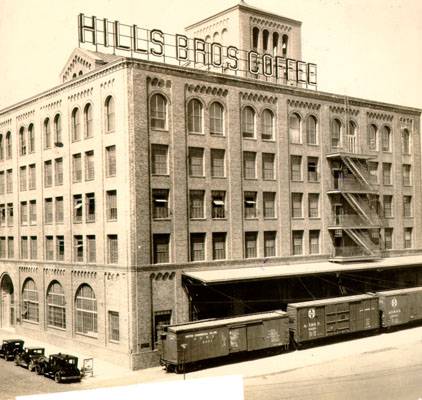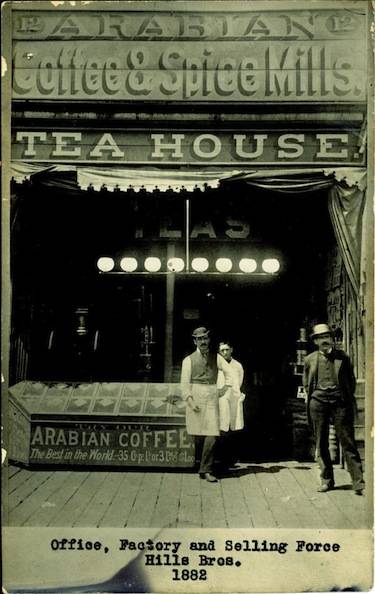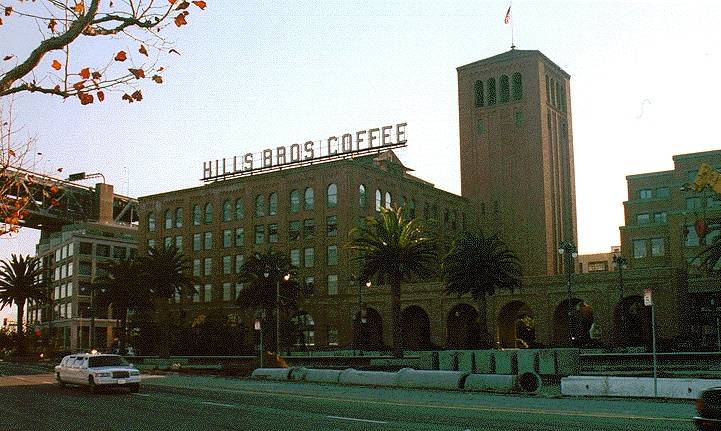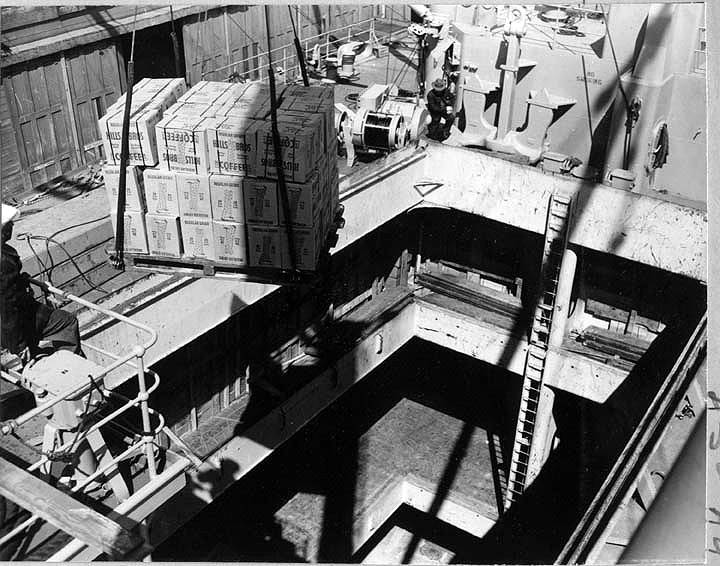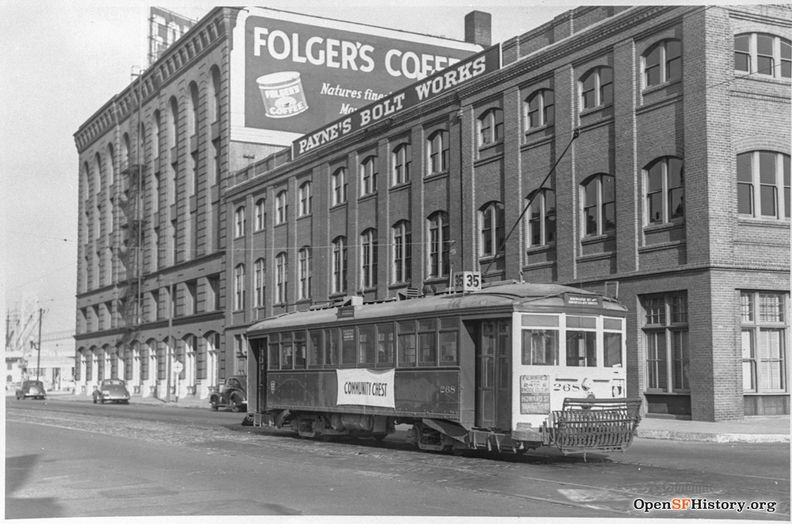HILLS BROTHERS COFFEE: Difference between revisions
m (added page content type) |
(added link) |
||
| (12 intermediate revisions by 3 users not shown) | |||
| Line 2: | Line 2: | ||
''courtesy Northern California Coalition on Immigrant Rights'' | ''courtesy Northern California Coalition on Immigrant Rights'' | ||
[[Image:Hills Bros Coffee 1940 AAC-7040.jpg]] | |||
'''Hills Brothers Coffee, 1940.''' | |||
''Photo: San Francisco History Center, San Francisco Public Library'' | |||
[[file:CoffeeHouse.jpg]] | |||
'''"Office, Factory and Selling Force Hills Bros. 1882"''' | |||
''Photo: San Francisco Museum and Historical Society'' | |||
[[file:Factory.jpg]] | |||
'''"Hills Bros. Building, San Francisco, Date: Dec. 15, 1924" | |||
''Photo: San Francisco Museum and Historical Society'' | |||
[[Image:soma1$hills-brothers-gentrified.jpg]] | [[Image:soma1$hills-brothers-gentrified.jpg]] | ||
| Line 7: | Line 28: | ||
'''The former Hills Brothers Coffee Building on the Embarcadero at Folsom, mid-1990s.''' | '''The former Hills Brothers Coffee Building on the Embarcadero at Folsom, mid-1990s.''' | ||
''Photo: Chris Carlsson | ''Photo: Chris Carlsson'' | ||
Embarcadero and Folsom: One of main industries that sprung up early in SOMA was the coffee industry. Starting in the late 19th century, San Francisco had become the largest west coast coffee provider by the 1920s, including companies like [[Hills Bros. Coffee—The Fulcrum Connecting San Francisco and El Salvador|Hills Bros.]], Folgers, and MJB. This industry provided the first link between San Francisco and Central America, where the coffee was grown. Following the industry, Central American laborers came to San Francisco in the early 20th century to work in processing plants and canneries. This explains San Francisco's unique connection to Central America, when most other California cities are historically predominantly Mexican. Most people think that Central Americans first came to San Francisco in the 1960s to 1980s, with the wars in Nicaragua and El Salvador, but many chose to come here because they already had family connections and community links going back to the early part of this century. | |||
The [[Working at Hills Bros. Coffee|Hills Brothers Factory]] has since been converted to offices, condominiums and a microbrewery catering to the new upscale South Beach professional clientele. | |||
[[Image:Hills-Bros-Coffee-on-pallet a0000159.jpg]] | |||
'''Hills Brothers coffee being unloaded from freighter on San Francisco shore, mid-20th century.''' | |||
''Photo: Online Archive of California'' | |||
[[Image:Folgers Coffee at Main and Howard 1938 wnp67.0462.jpg|792px]] | |||
'''Folgers Coffee advertising on side of their building at Main and Howard, 1938.''' | |||
''Photo: courtesy OpenSFHistory.org, wnp67.0462'' | |||
<iframe src="https://archive.org/embed/0251_Behind_the_Cup_The_Story_of_Hills_Bros_Coffee_22_40_02_00" width="640" height="480" frameborder="0" webkitallowfullscreen="true" mozallowfullscreen="true" allowfullscreen></iframe> | |||
'''"Behind the Cup," a self-promotional 16 minute silent film made in the 1930s by Hills Bros. Coffee company, showing the work done in El Salvador and then in the San Francisco factory under the Bay Bridge to produce the famous "Red Can" product that came to dominate coffee and mass-marketing in mid-century U.S. life.''' | |||
''Video: Prelinger Archive'' | |||
[[NO NOTHING CINEMA |Prev. Document]] [[Introduction to the SOMA |Next Document]] | [[NO NOTHING CINEMA |Prev. Document]] [[Introduction to the SOMA |Next Document]] | ||
[[category:SOMA]] [[category: | [[category:SOMA]] [[category:1880s]] [[category:1920s]] [[category:food]] [[category:1930s]] [[category:Salvadoran]] [[category:Nicaraguan]] | ||
Latest revision as of 15:09, 27 January 2021
Unfinished History
courtesy Northern California Coalition on Immigrant Rights
Hills Brothers Coffee, 1940.
Photo: San Francisco History Center, San Francisco Public Library
"Office, Factory and Selling Force Hills Bros. 1882"
Photo: San Francisco Museum and Historical Society
"Hills Bros. Building, San Francisco, Date: Dec. 15, 1924"
Photo: San Francisco Museum and Historical Society
The former Hills Brothers Coffee Building on the Embarcadero at Folsom, mid-1990s.
Photo: Chris Carlsson
Embarcadero and Folsom: One of main industries that sprung up early in SOMA was the coffee industry. Starting in the late 19th century, San Francisco had become the largest west coast coffee provider by the 1920s, including companies like Hills Bros., Folgers, and MJB. This industry provided the first link between San Francisco and Central America, where the coffee was grown. Following the industry, Central American laborers came to San Francisco in the early 20th century to work in processing plants and canneries. This explains San Francisco's unique connection to Central America, when most other California cities are historically predominantly Mexican. Most people think that Central Americans first came to San Francisco in the 1960s to 1980s, with the wars in Nicaragua and El Salvador, but many chose to come here because they already had family connections and community links going back to the early part of this century.
The Hills Brothers Factory has since been converted to offices, condominiums and a microbrewery catering to the new upscale South Beach professional clientele.
Hills Brothers coffee being unloaded from freighter on San Francisco shore, mid-20th century.
Photo: Online Archive of California
Folgers Coffee advertising on side of their building at Main and Howard, 1938.
Photo: courtesy OpenSFHistory.org, wnp67.0462
<iframe src="https://archive.org/embed/0251_Behind_the_Cup_The_Story_of_Hills_Bros_Coffee_22_40_02_00" width="640" height="480" frameborder="0" webkitallowfullscreen="true" mozallowfullscreen="true" allowfullscreen></iframe>
"Behind the Cup," a self-promotional 16 minute silent film made in the 1930s by Hills Bros. Coffee company, showing the work done in El Salvador and then in the San Francisco factory under the Bay Bridge to produce the famous "Red Can" product that came to dominate coffee and mass-marketing in mid-century U.S. life.
Video: Prelinger Archive

